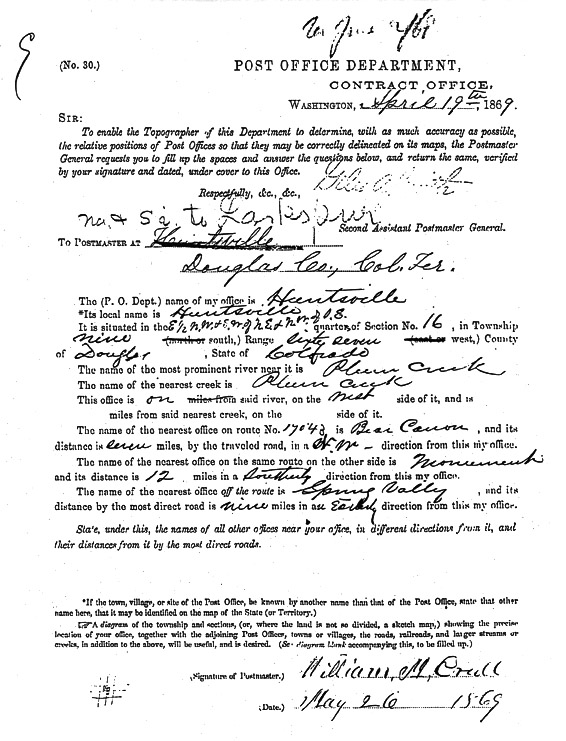| |
Huntsville
Discovery of gold in 1858 brought prospectors to
the area known today as Douglas County. Following the wake of gold
seekers were business people, farmers and ranchers seeking their
living from the new opportunities opened by the Pikes Peak or Bust
Gold Rush. Lush native grass in the creek valleys spoke of good soil
for cultivation and the thick stand of pines covering the hills
answered the need for timber.
The location of Huntsville, halfway between Denver City and Colorado
City, in the shelter of the high butte, on a live stream, surrounded
by heavy forest was a natural site of settlement. The post office
application dated January 14, 1862 states; �some 25 to 30 families and
perhaps 150 lumbermen near it.� Testimony of the attraction of the
valley is expressed in the words of the General Land Office survey or
field notes. �There are good farms in the valley of Plum Creek, June
29, 1866.
With the creation of Colorado Territory in February of 1861,
Huntsville became the first post office in Douglas County on January
22, 1862 with Daniel C. Oakes as postmaster for district 6. An earlier
post office had been established on west Plum Creek on March 24, 1860,
but discontinued by July 9, 1861. When the town of Huntsville on East
Plum Creek was settled the post office was re-established at that
location in 1862. Mail came to Huntsville, located below Hunts
Mountain, about two miles north of present day
Larkspur. This first
post office was discontinued on August 29, 1867 and later
re-established in April 8, 1869 with William Crull acting as the
second postmaster. Huntsville, so named for Alexander Cameron Hunt,
Territorial Governor of Colorado in 1867, was laid out circa 1859 by
Sarah Coberly, the first white woman in the Pikes Peak region. Mrs.
Coberly established �Coberly�s Half-Way House� hotel to accommodate
early freighters and stagecoach travelers along the territorial Road
coming from Auraria (Denver) along East Plum Creek to Colorado City
(Colorado Springs). The settlement, located midway between the two
cities, included a stage stop, Coberly�s Hotel, Oakes Mill (saw mill)
run by Major D. C. Oaks and served as a supply center for local
farmers and ranchers.
Rhyolite, heavy timber and clay made this area a choice site for
trade. Major Oaks, one of the first to arrive and search for gold in
Colorado Territory in 1858, helped spark the initial gold rush to the
Pikes Peak region by publishing a goldfield guide to the Pikes Peak
area. During the Indian uprisings in the 1860s, a nine room log stockade
known as Fort Lincoln or �Oakes Folly� was built on the Crull Ranch at
Huntsville to protect nearby ranchers from attack. Thirty families
took refuge for six months in 1864. Sarah married William Crull on May
7, 1865 after her first husband was killed in 1864. The Crull's left
Huntsville and moved to Denver circa 1870.
By September of 1871 the tracks of the Denver and Rio Grande Railroad
had reached the new community of Larkspur, south of Huntsville and the
Huntsville post office was re-named Larkspur and located in the Denver
and Rio Grande depot. It is interesting to note that the Larkspur post
office has been in continuous operation since 1871.
The Denver and Rio Grande Railroad tracks followed the old
Territorial
road from Castle Rock to Palmer Lake and later on to Colorado City.
The trail system in Greenland travels a portion of the original road.
In 1899, with the efforts of Senator Ammons of Douglas County, a bill
appropriating $5,000 for a bicycle path from Littleton to Palmer Lake
and eventually to Colorado Springs and Pueblo was passed. This path
would follow this Territorial road as it traverses to Palmer Lake.
Larkspur, named for the flower, which grows abundantly in the area,
then became the railroad town with freight of gypsum, clay, lumber,
creamery products and a passenger line. Ultimately the stagecoach
route to Huntsville was discontinued and Huntsville was a ghost town
by 1890.
Two floods have compromised the land surrounding the Huntsville area,
the first on May 7, 1864 destroying the Oakes sawmill and much of the
town, the second flood in June of 1965, that flood changing much of
the terrain around the base of Hunt Mountain and certainly washing
away any remaining material that might have been obtained from an
archaeological study of the area. Deep scaring, gouged by the torrent
of rainwater from both storms, still show on the west side of Hunt
Mountain. Slowly, vegetation is reclaiming the earth laid bare by the
forces of nature so long ago.

|
|

